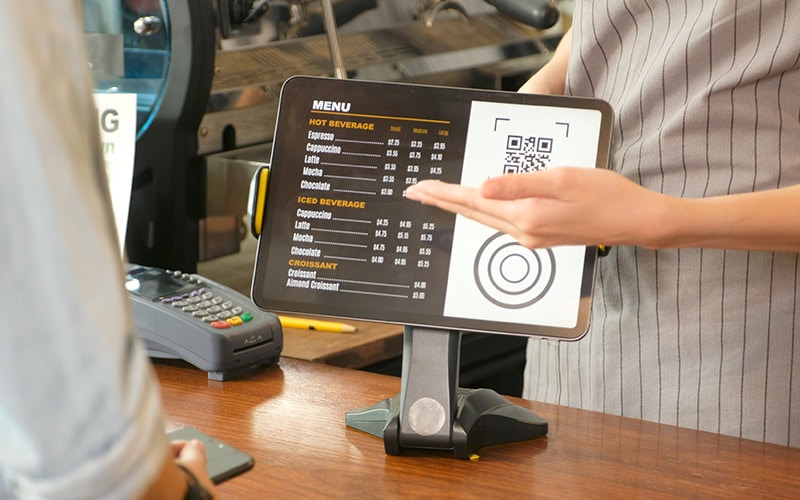
Insights
- A unified platform for company leaders and store workers across outlets can help quick service restaurants (QSRs) gain better visibility into order management and overall operations.
- The use of hyperscalers can help establish a unified platform with cost efficiency and speed.
- But first, QSRs need to adhere to best practices to implement the hyperscaler solution successfully. This includes partnering with a system integrator to implement the platform and standardizing its use across all outlets.

Energy, AI, and Sustainable Futures with Rice University’s Dr. Ramamoorthy Ramesh
Dr. Ramamoorthy Ramesh, Executive Vice President for Research at Rice University, discusses the transformative potential of material science, sustainable energy, and responsible AI.
Quick service restaurants (QSRs) operate in a fast-paced environment with high customer turnover, making efficient inventory management and streamlined operations critical. Striking the right balance in order volumes is essential to avoid understocking or overstocking, both of which can disrupt service. True to their name, QSRs operate with a sense of urgency: Orders are typically placed at the counter; many follow a self-service model; and speed is the defining factor for customer satisfaction.
Franchisees often operate semi-independently and have the flexibility to choose tools that suit their specific needs or budgets. If the franchisor hasn’t mandated a uniform tech stack or lacks a strong IT governance framework, franchisees often continue to use what they know or what’s most convenient. Some might opt for cheaper solutions rather than investing in platforms recommended by their brand.
Implementing a hyperscaler allows the franchiser to create a standardized platform for all franchisees, providing a unified view of operations and orders.
When franchisees of large QSR brands use disparate platforms for order management and day-to-day operations, it can result in fragmented data and a lack of visibility for employees and leadership at all levels. These factors can lead to confusion and slower decision-making.
Implementing a hyperscaler allows the franchiser to create a standardized platform for all franchisees, providing a unified view of operations and orders. This centralized visibility helps the brand plan more efficiently, streamline processes, and make data-driven decisions across its network.

Challenges facing QSRs
When QSR brands scale and spread, operational inefficiencies can easily creep in. With recent trade wars and their increasing tariffs sparking fears of inflation and other economic uncertainties, it is even more critical for businesses to streamline their operations and reduce overheads.
A US coffeehouse chain, with branches around the world, found itself in hot water when it saw that its US outlets were using disparate platforms for operations and order management. Some even maintained manual records with spreadsheets. With information scattered across multiple platforms and no single source of truth for operations data, the brand had limited real-time visibility across the chain and fragmented access to key business insights. Store employees and management lacked a unified platform to view accurate, up-to-date information on critical KPIs, daily activities, or orders. This hindered efficient decision-making and coordination among employees.
The situation led individual outlets to place repeated orders for food and drink ingredients such as coffee beans, and accessories such as cups and straws, meaning outlets were either overstocked or understocked.
This lack of insight across the outlets meant that management also found it challenging to make strategic decisions around the larger organization’s operations. For example, the head office rolled out promotional campaigns for different products and offered the franchisees gift cards for discounts on items they ordered for their stores. The effectiveness of those cards and the sales made were impossible to track as stores were using a range of different platforms to place orders.
Store managers were struggling as they didn't want to log in to multiple portals for multiple requirements. Additionally, maintaining different platforms was expensive due to the licensing costs the stores would have to pay for the various portals, as opposed to for a single platform.
Implementing a solution from a hyperscaler, such as Salesforce, Google Cloud Platform, or Microsoft Azure, can help QSRs create a standard platform for outlets across locations and have a unified view of operations and orders.

Resolving the issues
The coffeehouse chain reached out to Infosys for help with creating a storefront for their store managers’ use. The goal was to build a unified portal that store managers in over 15,000 stores across the US could log in to for different requirements, including viewing the orders placed. The platform also needed to cater to the senior leadership’s desire to get insights on the performance of individual stores to managing supply chains and reducing costs.
Another key objective was to enable the brand to track inventory levels across locations, and efficiently redistribute excess stock to stores needing top-ups, thus reducing waste and improving operational efficiency. The client also requested change management support for the project, including comprehensive training for all store managers to ensure smooth adoption and consistent use of the platform across locations. Additionally, the brand wanted to meet goals related to its impact on the environment.
Infosys implemented a Salesforce-based solution. Head office mandated the use of this platform across all its US outlets, replacing the patchwork of platforms they had been using before. Infosys created a store page with details such as schedules, customer features, order channels, inventory delivery information, and store programs.
However, the implementation had a few challenges. The data in the franchisees’ multiple legacy systems had to be cleaned up and reconciled into the new platform. In some cases, individual outlets asked for platform customizations based on their specific operational needs or preferences, such as menu display, products available on the shelf, and payment gateways. To accommodate this, tailored modifications were made to the standard platform template to offer flexibility to those outlets while maintaining overall system consistency.
Training sessions delivered as part of the roll out drove adoption of the new platform and ensured consistency of use.
Another objective of the common platform was to achieve product price optimization. The Infosys team worked with the client to analyze the product range with the aim of understanding customer preferences. This initially involved extensive Excel-based simulations and macros to test various pricing scenarios. Once validated, these pricing strategies were deployed to the Salesforce platform.
Infosys Salesforce practice also recommends license advisory services to help clients optimize their licensing costs. Access to the primary platform license was limited to key decision-makers, such as operational heads within the brand, while community-based licenses were implemented for franchisees. This approach strengthened security through role-based access controls to ensure appropriate user permissions and also significantly reduced costs by avoiding the need for franchisees to have individual licenses. Additionally, using a standardized platform offered franchisees clear visibility into their operations and enabled them to view invoices, manage returns, and place reorders. The creation of the store page helped business users with hassle-free automatic order creation and fulfilment without manual intervention.
Infosys implemented a minimum viable product or workable model for the brand’s 15,000 US outlets within three months as opposed to six months, which is typical for such implementations. This led to a 53% operational cost savings. The project also helped the client meet 25 standards across eight environmental impact areas, such as energy efficiency, water stewardship, and waste diversion.
Infosys implemented a workable model for the brand’s 15,000 US outlets within three months, and led to a 53% operational cost savings.

How to successfully implement a hyperscaler
While adopting a hyperscaler solution offers numerous advantages, companies must evaluate many factors to ensure successful implementation and derive business value.
Partnering with a system integrator or technology company that collaborates closely with hyperscalers is a smart first step. These tech partners can match a client’s needs with their knowledge of what the hyperscalers offer to identify the right products. Additionally, a tech partner’s established relationship with the hyperscaler can translate into cost advantages — such as reduced licensing fees — and guidance on optimizing licensing strategies.
To maximize the value of a new unified platform, brands must standardize its use across all outlets and phase out any legacy systems or manual processes. This transition should be guided by a well-defined change management strategy and executed in phases to minimize disruption, ensure business continuity, and drive consistent adoption across all stores and locations.
As the platform evolves through updates, new versions, and feature releases, brands must also invest in the regular training of their employees and business users so that they stay up to date with what the platform can do for them. For the coffeehouse client, Infosys delivered digital training across all of its stores in the United States.
Brands should ensure strong alignment among their internal teams — who understand the existing digital stack — and the technology partner responsible for integrating the new system. Regular sync-ups between both parties can help maintain clear communication, ensure smooth progress, and quickly address any emerging issues.
Using a hyperscaler to its fullest capacity requires data analysis on how stores are using the platform and determine how they can evolve their use of the platform. Data gathered from the unified platform helps leaders develop strategies across the business based on deep insights.
Finally, brands should constantly get feedback from the platform’s users and work with tech companies to make adjustments and improvements to maximize results.






